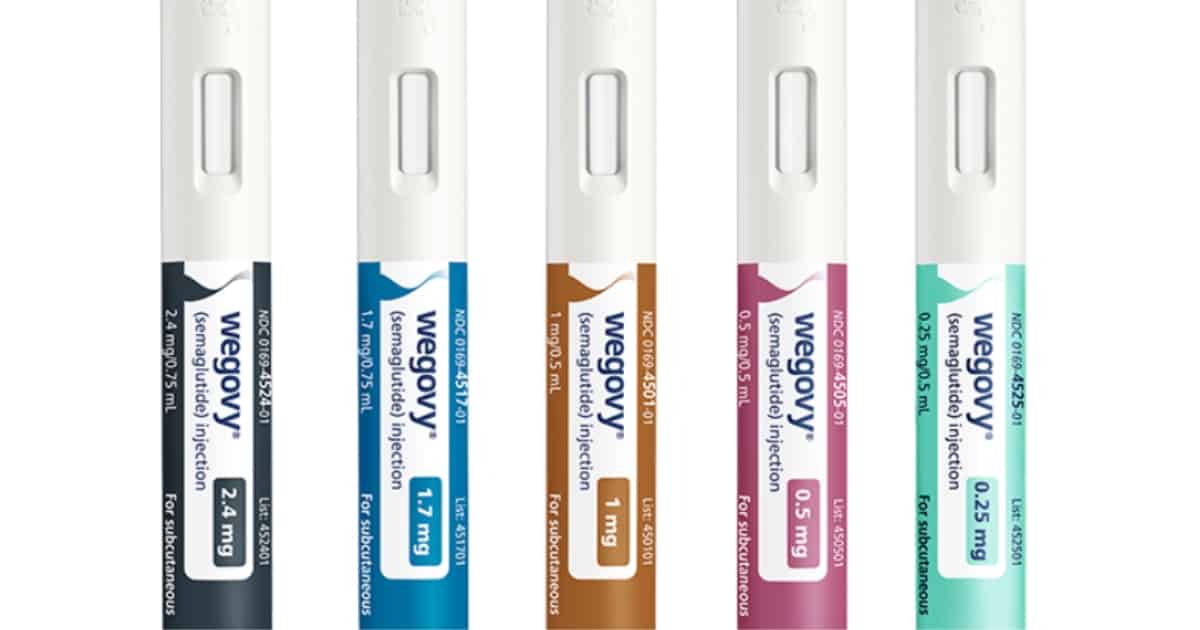
Wegovy is a once-weekly injectable medication that can help people lose weight.
It has also been shown to help people manage their blood sugar levels and decrease their A1c (a measure of glucose control over the previous 2 to 3 months).
Determining the appropriate dosage of Wegovy can take time. It should always be a decision made with your medical care team.
This article will discuss everything you need to know about Wegovy dosing.
Table of Contents
- What is Wegovy?
- What Wegovy dose do you typically start with?
- What are the different Wegovy pen doses?
- What is a normal Wegovy dose?
- How and when can you increase your dose?
- What do I do if I forget to take my dose of Wegovy?
- What is the largest dose of Wegovy?
- What are the side effects of Wegovy?
- How much Wegovy do you need to take for weight loss?
What is Wegovy?
Wegovy is the brand name for a weight-loss formulation of the medicine semaglutide, sharing the same active ingredient as the diabetes drugs Ozempic and Rybelsus.
Read more in: Ozempic vs. Wegovy: Which Drug Is Right for You?
Available as an easy-to-use auto-injector pen, it functions by suppressing appetite, slowing digestion, decreasing the liver’s release of glucose, and stimulating insulin release from the pancreas.
This helps reduce food intake and manage blood sugar levels.
Learn more in: Everything You Need to Know About Wegovy.
What Wegovy dose do you typically start with?
Wegovy is available in five dosages, tailored to your health history, goals, diet, and lifestyle.
Typically, providers start new users on a low dose to minimize potential side effects common with semaglutide medications.
The recommended starting dose is 0.25 mg once per week for the first 4 weeks. If this dose is well-tolerated without side effects, your doctor may gradually increase it over time.
What are the different Wegovy pen doses?
Wegovy pens come in five pre-measured dosages, each marked by distinct label colors to aid identification:
| Dose | Label Color |
| 0.25 mg | Teal |
| 0.50 mg | Pink |
| 1 mg | Brown/Orange |
| 1.7 mg | Blue |
| 2.4 mg | Dark Gray |
While all pens operate similarly, it’s important to use the pen that matches the dose prescribed by your doctor.
Always check that the packaging and pen are correctly labeled with the dosage in milligrams. Label colors may change, so ensure the dose is verified accurately.
Never exceed your prescribed dose to avoid potential adverse side effects.
See more in: Wegovy Injection Guide: Where and How to Inject?
What is a normal Wegovy dose?
Defining a “normal” dose of Wegovy is challenging, as people may tolerate different maximum doses without experiencing side effects.
The U.S. Food and Drug Administration (FDA) recommends starting with a low dose of 0.25 mg per week and gradually increasing to the maximum dose of 2.4 mg per week.
This highest dose, delivered by the 2.4 mg pen, is designed for long-term maintenance and is where many people eventually settle during their Wegovy treatment.
How and when can you increase your dose?
Your medical care team will guide you through gradual dose increases of Wegovy until you achieve a maintenance level suitable for long-term use.
Wegovy dose chart
Typically, for those new to semaglutide medications like Wegovy, the initial dosing schedule is as follows:
| Time Period | Dose |
| Weeks 1-4 | 0.25 mg once weekly |
| Weeks 5-8 | 0.5 mg once weekly |
| Weeks 9-12 | 1 mg once weekly |
| Weeks 13-16 | 1.7 mg once weekly |
| Week 17 and beyond | 2.4 mg once weekly |
At week 17 and onward, you may either stay at 1.7 mg weekly or increase to 2.4 mg, depending on the guidance from your healthcare provider.
This schedule may be adjusted based on your tolerance and any side effects you experience, such as persistent nausea.
Some people may need to maintain a lower dose longer than initially planned if they experience significant side effects. The FDA has approved a progression to a 2.4 mg dose, but individual adjustments may be necessary.
Always communicate any adverse symptoms to your provider and never increase your dose without medical guidance to avoid potential health risks.
What do I do if I forget to take my dose of Wegovy?
If you miss a dose of Wegovy, take it as soon as possible, but only within 5 days of the missed dose.
If more than 5 days have passed since the missed dose, skip it and do not try to make it up. Instead, continue with your next scheduled dose.
This helps ensure that you don’t double dose or disrupt the medication schedule, which could increase the risk of side effects.
What is the largest dose of Wegovy?
The largest weekly dose of Wegovy comes in the 2.4-mg dose pen. This pen usually has a dark gray label.
While a doctor might prescribe an “off-label” (in a manner not officially approved by the FDA) dose in some limited circumstances, the largest dose that is currently available is 2.4 milligrams per week.
Above this weekly dose, many people experience more noticeable side effects.
What are the side effects of Wegovy?
Wegovy users may experience common side effects such as nausea, vomiting, diarrhea, and tiredness.
More serious but rare side effects include thyroid tumors, pancreatitis, and changes in vision.
Hypoglycemia (low blood sugar) is also a concern, especially for those taking insulin.
Learn more in: Wegovy Side Effects: What You Need to Know.
How much Wegovy do you need to take for weight loss?
Clinical trials have demonstrated that people with overweight or obesity taking Wegovy, particularly at higher doses, experience significant weight loss.
For example, participants receiving the maximum dose of 2.4 mg per week saw an average body weight reduction of nearly 15 percent.
In contrast, those given a placebo (inactive treatment) only experienced a 2.4 percent weight loss, despite following the same exercise and dietary restrictions.
Learn more in Can Wegovy Help You Lose Weight? Did you find this article helpful? Click Yes or No below to let us know!





James hallahan
I’m type one diabetic and have started Wegovy, lowest dose about 3 weeks ago and am having the best control of my blood sugars ever. My A1C was 8.0 before, and can’t wait to see what they will be but I’m in range with my dexcom cgm and tandem pump 90% of time. Also I have lost 10 lbs so far, could lose another 25 lbs.
Marcy Patterson
i recently started Wegovy. I have lost 25 pounds in 5 weeks! It does tend to make me nauseous at times.And super tired the day I get my shot! marcy